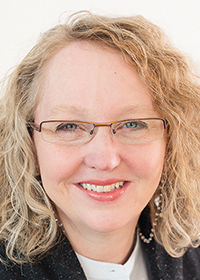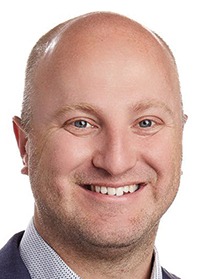Design firm leaders discuss trend lines for new projects, industry changes
by February 9, 2022 1:46 pm 1,124 views

Chris Baribeau, principal and co-founder of Fayetteville firm Modus Studio.
Despite a period of economic ups and downs during the pandemic, construction and design did remain active, and many projects were completed in 2021. But how do the design prospects look in the longer term?
The Northwest Arkansas Business Journal consulted some of the region’s leading architects to get a sense of their prospects for the year ahead and the coming years.
The NWABJ asked, what is your outlook, generally, for new projects the rest of 2022 and into 2023? What do you expect your design board to look like?
“Our design board is filled with multiple project types. What is great about the development pattern in Northwest Arkansas is that clients are innovating ideas to support a great lifestyle environment in our area. That turns into a wide variety of project types within a given market, and with multiple markets on our design board it becomes exponential in terms of design challenges and solutions.”
— Ryan Faust, partner and managing principal, BUF Studio
“New projects are filing in. Our boards are filling up with many large-scale multifamily, K-12, hospitality, and commercial projects as well as a strong surge of custom home projects. Our internal project filter has to focus on the qualitative attributes of potential projects; keying in on opportunities to work with like-minded clients for impactful, sustainable, placemaking architecture.”
— Chris Baribeau, principal and co-founder, Modus Studio
“As Northwest Arkansas continues to grow, we see strong demand in healthcare, multi-family and even office space. But with broad growth in the area, there is a need for architectural design in almost all project types.”
— Craig Curzon, principal, Polk Stanley Wilcox
“Some have expressed an underlying concern that rising construction costs paired with labor shortages will cool down the design and construction industry. However, DEMX has a rather diverse group of clients and project types. We have a significant backlog of work and continue to field new project inquiries. We expect to remain busy for the foreseeable future.”
— Tim Maddox, principal, DEMX Architecture

“We continue to serve our existing clients and explore new target opportunities. We’re optimistic about 2022, as well as 2023, as Northwest Arkansas continues to grow.”
— Gail Shepherd, partner, Hight Jackson Associates
“As an AE firm with multiple studio locations throughout the U.S. and Mexico, much of our work consists of partnering with national clients. Because of this, in 2021 we experienced significant growth. Our expectations for the next two years will be a continued upward growth trend, however not at the rate we experienced in 2021. We expect that design for renovation will continue to lead our new construction projects as clients work to adjust their facilities to meet the accelerated changes driven by the pandemic, supporting the evolving user/customer demands.
“The market sectors we expect to see growth in 2022 and 2023 will be: food retail, logistics, mixed-use real estate development, entertainment, energy services, and fast casual dining.”
— Dave Wilgus, CEO, HFA
“Our outlook is very positive, with backlog projected into 2023. The variety of projects and clients continues to grow.
- We anticipate leveling out our staffing needs by mid-2022. Redevelopment schedules have shortened to accommodate critical path milestones as our clients’ strategic plans alter.
- Many of our new construction schedules have been pushed out, mostly supply chain issues with steel.
- There is a lot of emphasis on remodels and re-development of empty buildings.”
— Doug Hurley, president, pb2 architecture + engineering
“Our 2022 project backlog remains strong. Many new projects which were put on hold in Q1 of 2020 are now ready to resume design. MBL is cautiously optimistic about 2023, with our biggest concerns being the rapid rise in construction prices.”
— Roger Boskus, president, MBL Architecture
“Our design outlook for the rest of 2022 and 2023 is looking very positive, and we are expecting new growth. Currently, our design board is quite full, and given the range and diversity of building types and the scales of projects that we are working on, we imagine that work in manufacturing, healthcare, and hospitality will continue to expand. We expect to have more diversity in our project types and scales. Looking to 2023, we will have a variety of large and small scale projects in design phases and under construction.”
— Marlon Blackwell, founder and principal, Marlon Blackwell Architects
“We expect to show continued growth for our company and our clients. Our design board will remain full, we will continue to offer more job opportunities, and expand our services. We are not only excited about the growth but the quality of the work we are participating in.

“There are several projects in our pipeline that we believe will have a significant impact on our community’s sense of place and connection to each other. Creating places people love through art and architecture is our passion, and we are excited to be working on projects that make an impact in Northwest Arkansas.”
— Jessica Hester, CEO and principal architect, Verdant Studio
The NWABJ asked, tell me where you see the biggest changes coming in the architecture industry in the next few years? What’s going to be different from the current business model?
“We are going to need to be creative about how we look for talent in our industry. We will need to leverage our internal team and their different strengths to provide options quickly for our clients and team with quality partners working alongside us in order to streamline the delivery of our projects.
“Another looming challenge is the rise in construction costs and how we as a design firm react to that environment. I think the business model for architecture could shift into a larger blend of design and construction to help inform the design community on how to create designs that temper rising costs and create success for clients against tight budget constraints.”

— Ryan Faust, partner and managing principal, BUF Studio
“Construction demand and pricing is high, schedules are expected to be shorter, and competition for craft-driven designers is intense. The housing crisis is real, and we are at a critical juncture on being able to steer the course on what we want our Ozark landscape to look like. The next few years are going to realize that firms with quality design-thinking processes and creative aspirations will be leading the conversation about how we continue to build Northwest Arkansas.”
— Chris Baribeau principal and co-founder, Modus Studio
“Architects will have to continue to leverage technology in new ways in terms of how projects are imagined and presented. In the spirit of our society generally wanting everything quicker today, I believe architects will also need to use technology in ways that will decrease the time to get to design approval and also the time to get to construction and do it while working with suppliers and contractors to give building owners more reliable cost data throughout the process.”
— Craig Curzon, principal, Polk Stanley Wilcox
“Like most other industries, I think the biggest changes will come from the labor shortage and the Great Resignation. Shorter work weeks, work-from-home options, and higher compensation will continue to be the trend for a while. Businesses will need to adapt to these changes.”
— Tim Maddox, principal, DEMX Architecture

“Our business model has shifted and evolved over the past 45 years, in response to many exterior forces. We expect that to continue into the future, but typically, those shifts happen slowly. The thing we agree is important is to never lose sight of the values and goals we were founded on.
“In the more immediate we think Northwest Arkansas will continue to see the innovation of sustainable materials and their integration into our local built environment. And, with the rapidly changing costs and supply chain issues, we have to be actively monitoring the market so we can adjust according to protect our projects and clients.”
— Gail Shepherd, partner, Hight Jackson Associates
“Finding and keeping talented professionals is the biggest challenge we face in our industry. To better respond to changing workplace environments, we have adapted our business model to include a ‘work from anywhere’ approach as we continue to recruit new talent. We no longer want location to limit our recruiting potential, and we intend to leverage our investment in technology to better support that talent, no matter where they reside.
“This does bring up its own challenges, however, and we must be diligent in making sure our company culture and values are reinforced and upheld by all our people. By continuing to leverage meticulous business planning we can better engage our people to meet their professional goals, as well.”
— Dave Wilgus, CEO, HFA
“The ability to pivot and change course quickly and efficiently will determine success and profit.
- Knowledge of who is doing what, especially startups that are solving issues quickly who may be able to offer better current solutions.
- Extensive use of a variety of tech to create more accurate documents and a realistic image for the client. For example, laser scanning existing conditions.
- Adjustments to staff to include a remote workforce both locally and nationally.”
— Doug Hurley, president, pb2 architecture + engineering
“As our community continues to grow rapidly, much of the inexpensive prime vacant land and green fields have been developed over the past 20 years. Architects and urban planners will be instrumental in adding value to owners by the exploration of ways to densify sites which will soon be prime for repurposing or development. Exceptionally well-designed buildings and master-planned communities will be the most desired places to work, live and play.”
— Roger Boskus, president, MBL Architecture

“Some of the biggest changes I see in the architecture industry in the next few years will be how the industry is having to reevaluate how they work, both virtually and in person, and consider the firm’s ability to remain flexible in the face of unforeseeable events. We will continue to experience the ripple effects of the pandemic, and it will affect the nature of the office and the process by which we deliver projects.
“Additionally, I think there will be changes in how data is used to influence code and policy and inform good design — the entire lifecycle of a building, from conception to realization and beyond, is going to become increasingly necessary to underscore the value of our work.
“With the future business model, I foresee more problem seeking in addition to problem solving. I believe we will see architecture becoming more proactive in developing strategic partnerships and they will also become more research oriented as firms work to generate their own projects to address present day issues and problems.
 “I think we will also begin to see the business model look for more ways to be socially responsible and impactful through their work. In the future it won’t be enough to just have a beautiful building — it will now have to demonstrate its impactfulness and the social and environmental context that we are operating in. Our virtual interface with the public, review boards, and stakeholders will continue to expand.”
“I think we will also begin to see the business model look for more ways to be socially responsible and impactful through their work. In the future it won’t be enough to just have a beautiful building — it will now have to demonstrate its impactfulness and the social and environmental context that we are operating in. Our virtual interface with the public, review boards, and stakeholders will continue to expand.”
— Marlon Blackwell, founder and principal, Marlon Blackwell Architects
“The architecture industry, like many professional service industries, has been slow to change. We expect that this year will be a continued increase in the use of technology, specifically opportunities to share spaces virtually with our client and the community through virtual reality and immersive environments. We see growing space for creative strategy work as Northwest Arkansas continues to invest in placemaking and quality-of-life experiences. We also expect there to be a steady, if not significant, increase in both active and passive sustainable technology deployment.”
— Jessica Hester, CEO and principal architect, Verdant Studio
